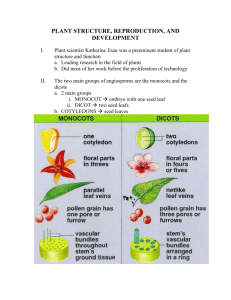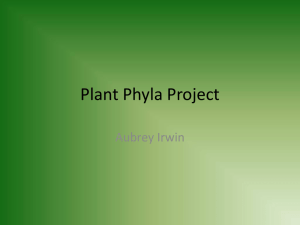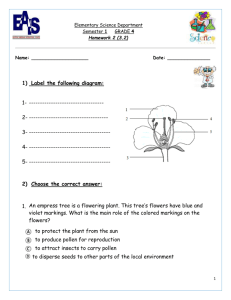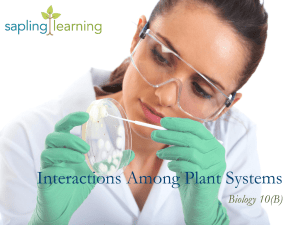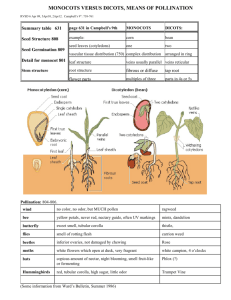Biology II Weeks 6-9: September 21st
advertisement
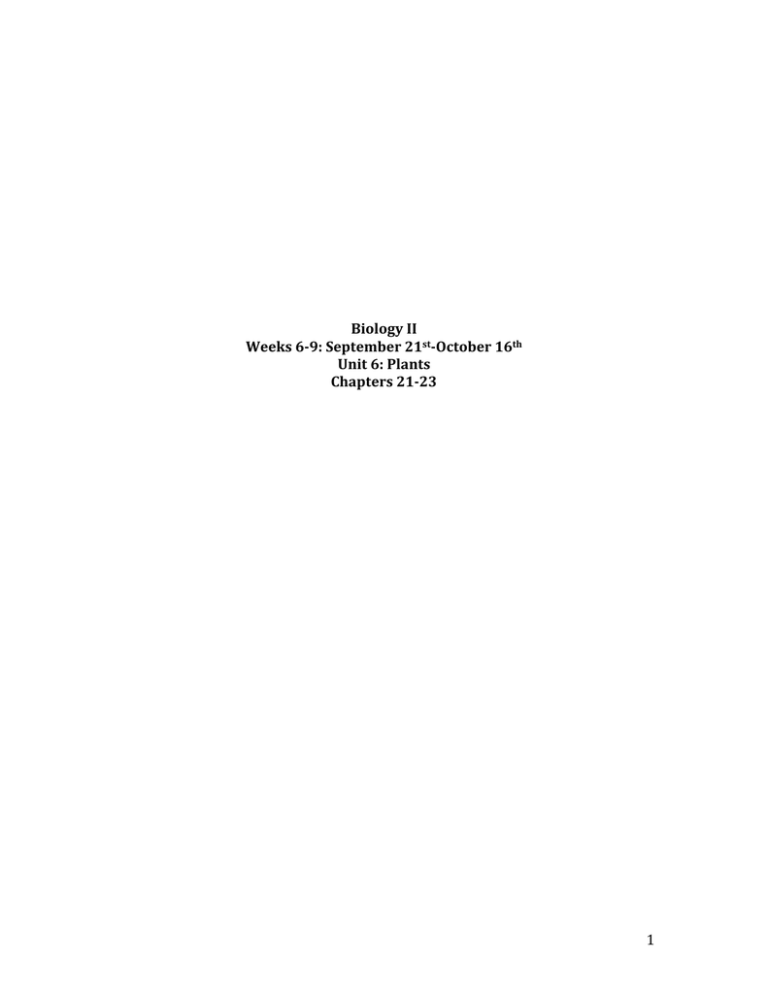
Biology II Weeks 6-9: September 21st-October 16th Unit 6: Plants Chapters 21-23 1 Unit 6 Outline Chapter 21: Introduction to Plants Section 1: Plant Evolution and Adaptations* A. Plant Adaptations to Land Environments 1. Cuticle 2. Stomata 3. Vascular Tissues 4. Reproductive Strategies 5. Seeds B. Alternation of Generation C. Plant Classification Section 2: Nonvascular Plants A. Diversity of Nonvascular Plants 1. Division Bryophyta 2. Division Anthocerophyta 3. Division Hepaticophyta Section 3: Seedless Vascular Plants A. Diversity of Seedless Vascular Plants 1. Division Lycophyta 2. Division Pterophyta Section 4: Vascular Seed Plants A. Diversity of Seed Plants 1. Division Cycadophyta 2. Division Gnetophyta 3. Division Ginkgophyta 4. Division Coniferophyta 5. Division Anthophyta Chapter 22: Plant Structure and Function Section 1: Plant Cells and Tissues A. Plant Cells 1. Parenchyma cells 2. Collenchyma cells 3. Sclerenchyma cells B. Plant Tissue 1. Meristematic tissue a. Apical meristems b. Intercalary meristems c. Lateral meristems 2. Dermal tissue—the epidermis a. Stomata b. Trichomes c. Root hairs 3. Vascular tissues a. Xylem b. Phloem 2 4. Ground tissue Section 2: Roots, Stems, and Leaves A. Roots 1. Root structure and growth 2. Types of roots B. Stems 1. Stem structure and function 2. Growth of a stem 3. Types of stems C. Leaves 1. Leaf structure 2. Gas exchange and transpiration 3. Characteristics of leaves 4. Leaf modifications Section 3: Plant Hormones and Responses A. Plant Hormones 1. Auxin 2. Gibberellins 3. Ethylene 4. Cytokinins B. Plant Responses 1. Nastic responses 2. Tropic responses Chapter 23: Reproduction in Plants Section 1: Introduction to Plant Reproduction A. Vegetative Reproduction 1. Naturally occurring vegetative reproduction 2. Directed vegetative reproduction B. Alternation of Generations C. Moss Reproduction and Life Cycle D. Fern Reproduction and Life Cycle E. Conifer Reproduction and Life Cycle 1. Male cones 2. Pollination 3. Seed development Section 2: Flowers A. Flower Organs B. Flower Adaptations 1. Structural Differences 2. Pollination mechanisms a. Self pollination and cross pollination b. Animal pollination c. Wind pollination 3. Photoperiodism a. Short-day photoperiodism b. Long-day photoperiodism 3 c. Intermediate-day photoperiodism d. Day-neutral photoperiodism Section 3: Flowering Plants A. Life Cycle 1. Gametophyte development 2. Pollination and fertilization B. Results of Reproduction 1. Seed and fruit development 2. Seed dispersal 3. Seed germination 4 Chapter 21 Objectives 1. Students will recall all Chapter 21 vocabulary words. 2. Students will describe the adaptations of plants to land environments. 3. Students will describe alternation of generations of plants. 4. Students will list the divisions of the plant kingdom. 5. Students will identify the structures of nonvascular plants. 6. Students will recall the characteristics of seedless vascular plants. 7. Students will compare and contrast the seed plants. 8. Students will list the divisions of gymnosperms. 9. Students will grow different plants to understand life cycles of plants. 10. Students will collect leaves from different types of plants. Chapter 22 Objectives 1. Students will recall all Chapter 22 vocabulary words. 2. Students will identify the major types of plant cells. 3. Students will describe the major types of plant tissues. 4. Students will describe the structures of roots, stems, and leaves related to their functions. 5. Students will list the major types of plant hormones. 6. Students will evaluate how hormones affect the growth of plants. 7. Students will compare how the different types of plant responses are alike. 8. Students will perform experiments to test hormone affects on plant growth. 9. Students will perform experiments to test plant responses. Chapter 23 Objectives 1. Students will recall all Chapter 23 vocabulary words. 2. Students will evaluate the advantages of vegetative reproduction. 3. Students will compare the reproductive stages among mosses, ferns, and conifers. 4. Students will recall the parts of a flower and describe their functions. 5. Students explain what complete, incomplete, perfect, and imperfect flowers are. 6. Students will contrast monocot and eudicot flowers. 7. Students will describe the life cycle of a flowering plant. 8. Students will describe the process of fertilization and seed formation in flowering plants. 9. Students will describe the different methods of seed dispersal and give examples. 10. Students will study the affects of plants on insects. 5 Pass Skills Being Evaluated in Unit 6 Process Standards Process Standard 1: Observe and Measure 1. Identify qualitative and quantitative changes in cells, organisms, populations, and ecosystems given conditions (e.g., temperature, mass, volume, time, position, length, quantity) before, during, and after an event. 2. Use appropriate tools with accuracy and precision (e.g., microscope, pipette, metric ruler, graduated cylinder, thermometer, balance, stopwatch) when measuring cells, organisms, populations, and ecosystems. 3. Use appropriate International System of Units (SI) (i.e., grams, meters, liters, degrees Celsius, and seconds) and SI prefixes (i.e., micro-, milli-, centi-, and kilo-) when measuring objects and/or events. Process Standard 2: Classify 1. Using observable properties, place cells, organisms, and/or events into a biological classification system (e.g., dichotomous keys, taxonomy charts, cladograms). 2. Identify the properties by which a biological classification system is based. Process Standard 3: Experimental Design 1. Evaluate the design of a biology laboratory experiment. 2. Identify the independent variables, dependent variables, controlled variables, and control set-up in an experiment. 3. Use mathematics to show relationships within a given set of observations (e.g., population studies, biomass, probability). 4. Identify a hypothesis for a given problem in biology investigations. 5. Recognize potential hazards and practice safety procedures in all biology activities. Process Standard 4: Interpret and Communicate 1. Select appropriate predictions based on previously observed patterns of evidence. 2. Report and display data using appropriate-technology and other media. 3. Interpret data tables, line, bar, trend, and/or circle graphs from existing science research or student experiments. 4. Determine if results of biological science investigations support or do not support hypotheses. 5. Evaluate experimental data to draw the conclusion that is best supported by the evidence. 6. Routinely prepare a written report describing the sequence, results, and interpretation of a biological investigation or event. a. Establish and maintain a formal style and objective tone. b. When appropriate or possible, utilize technology to produce, publish, or revise writing products. c. Gather relevant information from multiple authoritative print and digital sources and follow a standard format for citation, avoiding plagiarism. 7. Communicate or defend scientific thinking that results in conclusions. a. Read, comprehend, and represent evidence from a range of sources (e.g., texts experiments, or simulations) to support conclusions. b. Recognize bias in observation/research. 8. Identify and/or create an appropriate graph or chart from collected data, tables, or written description (e.g., population studies, plant growth, heart rate). a. Translate quantitative information expressed in words into visual form (e.g., a table or chart). b. Translate information expressed visually or mathematically (e.g., a table, chart or equation) into words. Process Standard 5: Model 1. Interpret a biological model, which explains a given set of observations. 2. Select predictions based on models (e.g., pedigrees, life cycles), and when appropriate, apply mathematical reasoning to make accurate predictions. 3. Compare a given model to the living world. 6 Process Standard 6: Inquiry 1. Ask a scientific question, formulate a testable hypothesis, and design an appropriate experiment relating to the living world. 2. Design and conduct biological investigations in which variables are identified and controlled. 3. Use a variety of technologies (e.g., probes, handheld digital devices, electrophoresis equipment, digital cameras, software, calculations, digital balances, microscopes, measuring instruments, and computers) to collect, analyze and display data. 4. Inquiries should lead to the formulation of explanations or models (physical, conceptual, and mathematical). In answering questions, students should engage in research and discussions (based on scientific knowledge, the use of logic, and evidence from the investigation) and arguments that encourage the revision of their explanations, leading to further inquiry. 7 Daily Lesson Plans Week 6: September 21st-25th 21st: Read Chapter 21, Write Out Vocabulary, Unit Project 22nd: Unit 6 Lab 23rd: Chapter 21 Lecture, Worksheet, & Quiz 24th: Unit 6 Lab 25th: Chapter 21 Study Guide/Zeros Report Week 7: September 28th-October 2nd 28th: Chapter 21 Study Guide Review 29th: Chapter 21 Review (Jeopardy) 30th: Chapter 21 Test 1st: Unit 6 Lab 2nd: Unit 6 Lab/Zeros Report Week 8: October 5th_9th 5th: Read Chapter 22, Write Out Vocabulary, Unit 6 Project 6th: Unit 6 Lab 7th: Chapter 22 Lecture, Worksheet, & Quiz 8th: Unit 6 Lab 9th: Chapter 22 Study Guide/Zeros Report Week 9: October 12th-16th 12th: Chapter 22 Study Guide Review/Lab 13th: Chapter 22 Review (Jeopardy)/Lab 14th: Chapter 22 Test/Zeros Report (1/2 Day) 15th: No School-Fall Break 16th: No School-Fall Break Week 10: October 19th-23rd 19th: No School 20th: Read Chapter 23, Write Out Vocabulary, Unit 6 Project 21st: Chapter 23 Lecture, Worksheet, & Quiz 22nd: Unit 6 Lab 23rd: Chapter 23 Study Guide/Zeros Report Week 11: October 26th-30th 26th: Chapter 23 Study Guide Review 27th: Chapter 23 Review (Jeopardy) 28th: Chapter 23 Test 29th: Finish Unit 6 Lab 30th: Unit 6 Review/Zeros Report 8

